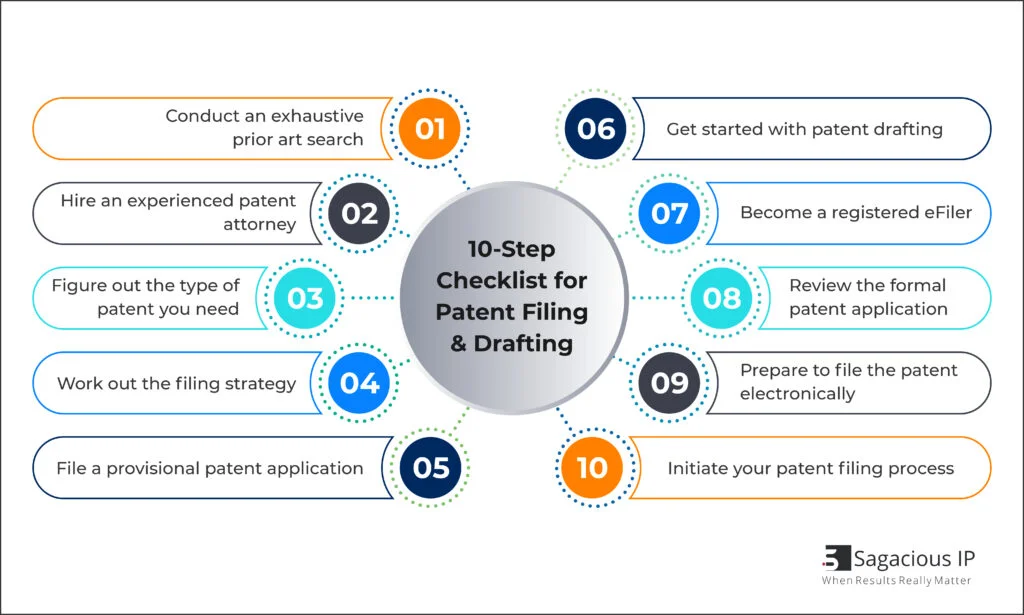10-Step Checklist for Successful Patent Drafting and Filing
Have you stumbled upon an invention that is unique, useful, and non-obvious? If so, it’s crucial to patent it without delay. Failing to do so may allow others to profit from your ingenuity, potentially undermining your competitive advantage. However, securing a patent is a complex process fraught with potential pitfalls, particularly in patent drafting. A methodical approach is essential to ensure you don’t overlook any critical details. In this article, we present a comprehensive 10-step checklist to guide you through patent drafting and filing, ensuring your innovative ideas are protected.
Table of Contents
10 Key Steps to Effective Patent Drafting
Each of these steps is crucial for ensuring a smooth patent application process and maximizing your chances of success.

Step 1: Conduct a Thorough Prior Art Search
Before investing time or money in the patent process, perform an exhaustive prior art search. This is vital to confirm that your invention hasn’t already been patented. Utilize databases from the USPTO and WIPO for extensive research. While this step may seem tedious, it can save you significant time and resources down the line. If needed, consider outsourcing this task to an IP service provider for expert assistance.
Step 1: Hire a Skilled Patent Attorney
Once you’ve confirmed that your invention is patentable, engage a competent patent attorney. An experienced attorney can navigate the complexities of patent drafting and help you avoid critical errors that could jeopardize your application. Their expertise is invaluable in deciphering the legal jargon associated with the patent process.
Step 3: Determine the Type of Patent Required
The USPTO issues three primary types of patents:
- Utility Patent: For new processes, machines, or compositions of matter.
- Design Patent: For ornamental features of an object.
- Plant Patent: For new plant varieties that can be asexually reproduced.
Understanding the type of patent you need will shape your patent drafting and application strategy.
Step 4: Develop Your Filing Strategy
Decide whether you want your invention protected solely in the US or globally. If international protection is your goal, consult the Office of International Patent Cooperation (OIPC) for guidance on your options.
Step 5: File a Provisional Patent Application
In the US, the first-to-file system grants patent rights to the first person who files, not necessarily the first inventor. To secure a priority date, file a provisional patent application. This step allows you a year to refine your invention while maintaining protection, as long as you submit a non-provisional application within 12 months.
Step 6: Begin Patent Drafting
Effective patent drafting requires a detailed description of your invention, including claims about its scope, an abstract, background information, and a summary. Clearly outline the legal protection you seek. Given the intricacy of this task, collaborating with your patent attorney and industry experts is highly recommended.
Step 7: Become a Registered eFiler
While you can file a patent application via fax or email, the most efficient method is through the USPTO website. Familiarize yourself with their online resources and register as an eFiler to streamline the application process.
Step 8: Review Your Patent Application Thoroughly
Thoroughly reviewing your patent application is crucial. Even minor errors can lead to significant setbacks. It’s advisable to review the application multiple times. Errors may limit your patent protection, so diligence in this stage is key.
Step 9: Prepare for Electronic Filing
As a registered eFiler, utilize the Electronic Filing System (EFS) of the USPTO. This system enables you to save and submit documents electronically, making the process more efficient.
Step 10: Initiate Your Patent Filing Process
Once you file your application, the USPTO will assign a patent examiner to your case. Maintain open communication with your examiner and promptly address any correspondence from the patent office. If your attorney applied, correspondence will be directed to them.
Conclusion
Securing a patent is a critical step in protecting your innovative ideas, especially considering that the USPTO can take two to four years to grant a patent, with 30-40% of applications facing rejection due to drafting errors or insufficient prior art research. Given the considerable investment of time and resources in this process, meticulous preparation of your application is paramount. By following this comprehensive 10-step checklist for patent drafting, you not only streamline your application but also significantly increase your chances of obtaining strong intellectual property protection. Each step is strategically designed to minimize risks and ensure that your creativity remains yours, empowering you to flourish in your industry without fear of infringement.
At Sagacious IP, we provide customized patent drafting services that meet all regulatory requirements while ensuring extensive protection against potential competitors. With over 16 years of experience and a team of 500+ patent professionals, we excel in drafting applications across various jurisdictions. Our solutions are cost-effective, results-driven, and characterized by quick turnaround times, making us the preferred partner for corporations, law firms, and inventors alike. We are here to support you through every stage of the patent process.
Don’t leave the future of your innovation to chance — contact us today to secure the protection your invention rightfully deserves!
– The Editorial Team
Having Queries? Contact Us Now!
"*" indicates required fields




